LOUVERS for LOOKS
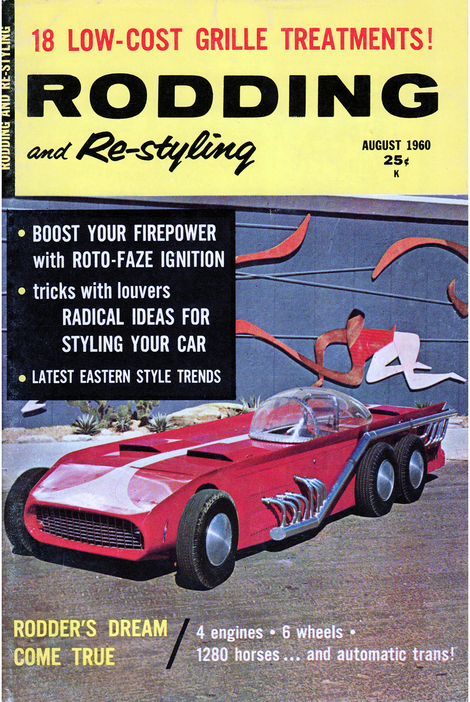
Recreated from Rodding and Re-Styling August 1960
Trend setting re-stylers are adding punch to their cars' appearance with varied patterns of air slots - and they only scratched the surface.....................
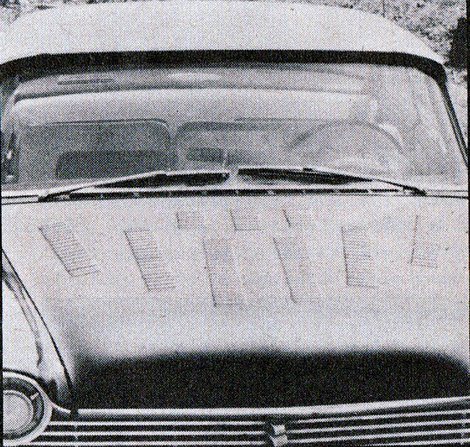 Hoods are more likely than other parts of a car for two reasons the openings are functional there and the hood can be easily removed for the punching process. There's is no end to the variety of designs. Formation of staggered columns was preferred by the owner of this '57 Plymouth.
Hoods are more likely than other parts of a car for two reasons the openings are functional there and the hood can be easily removed for the punching process. There's is no end to the variety of designs. Formation of staggered columns was preferred by the owner of this '57 Plymouth.
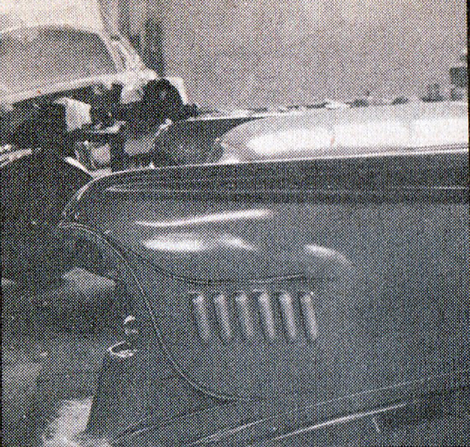 A louver operation is a simple or as complicated as you make it. Louvered section shown started out as a piece of sheet metal which received the punch treatment before it was molded to the body of a '56 Chevrolet.
A louver operation is a simple or as complicated as you make it. Louvered section shown started out as a piece of sheet metal which received the punch treatment before it was molded to the body of a '56 Chevrolet.
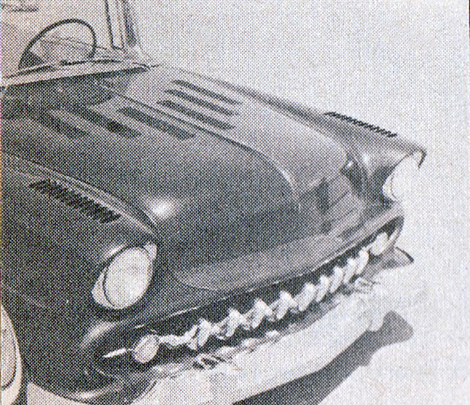 Fender treatments compliment louvered hood on an '56 Chevrolet. The fenders had to be removed.
Fender treatments compliment louvered hood on an '56 Chevrolet. The fenders had to be removed.
 Removable louvers: Nothing major about this operation. "59 Chevy owner simply took off his skirts, removed paint, had louvers done and repainted skirts.
Removable louvers: Nothing major about this operation. "59 Chevy owner simply took off his skirts, removed paint, had louvers done and repainted skirts.
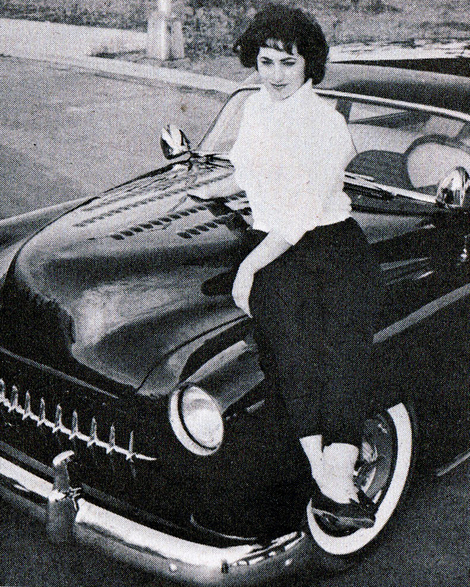
At a recent car show, one the exhibitors was asked by a spectator whether the louvers in his car's wheel discs were functional."of course they're funtional," the car owner replied. "They help me win extra points."
The sentiment of many a re-styler is reflected in that statement. After all, if something is intended to look good, isn't its function that of pleasing the eye? Sure louvers cut in a hood may serve to permit greater air flow around the engine. But situated any where else on a car, louvers are 50 times out of 100 are for looks.
Here are five check pionts that should seriously be considered when planning a louver operation:
- Location.
On the hood, be sure the openings are not situated over the distributor and spark plugs. Of course, the hood isn't the only likely part that's detachable and therefore louver-able. You also have skirts, wheel discs, front fenders, gravel pans, Connie kits, etc.
- Number.
Don't over due it. Too many louvers may spoil the overall appearance.
- Size.
The width of louvers should be determined by the shape of the part to be puncheda s well as the inherent shape of the car as a whole.
- Pattern.
A little paper work can be a big help in obtaining a unique design. Try sketching a number of geometric arrangements - staggered rows, contour lines, wedged shaped pattern, etc. Then draw up a full-scale plan of the design for the machinist to follow.
- Angle.
Consider the angle of the louvers themselves in relation to the car's lines. You can then decide whether the slots should be horizontal, vertical, or diagonal.
Now for the job itself. An enterprising car owner can, if he has special tools, time and skill, do the job himself. But all told, it's a tricky undertaking. For all practical purposes, the best way to get the work done is to farm it out to a machine shop that has the equipment and charges on the average, from 15 to 20 cents a louver. It's a good idea, therefore, to check with friends or local body shop to find out the louver shop nearest you.
Shown here are some of the ginchiest louver treatments to be found anywhere - a sample unlimited. And see how a typical job is done step by step coming up.
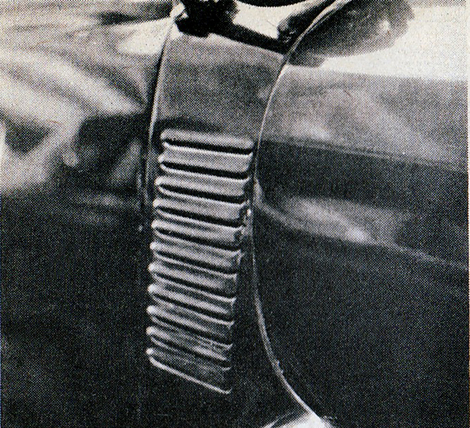 Holy cowl! Another instances where louvers are punched in sheet metal which is shaped to fit the body. Job was done on a '46 GMC truck.
Holy cowl! Another instances where louvers are punched in sheet metal which is shaped to fit the body. Job was done on a '46 GMC truck.
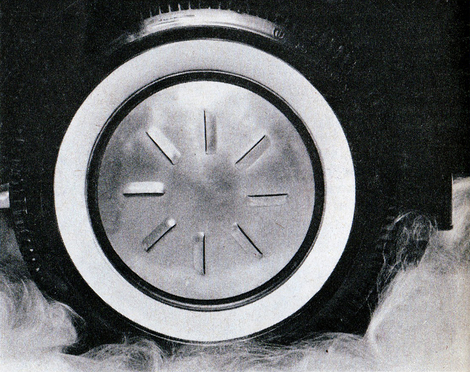 Aluminum moon wheel disc shows louvers to advantage. In such cases, there is no danger of denting disc, since area punched is small.
Aluminum moon wheel disc shows louvers to advantage. In such cases, there is no danger of denting disc, since area punched is small.
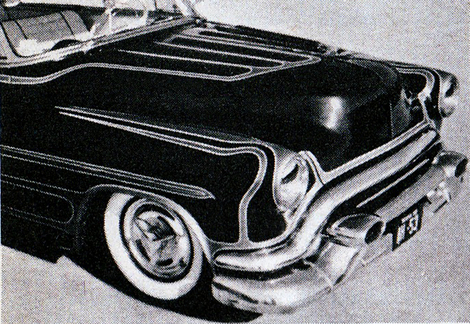 Three rows of louvers flanking hood peak on '52 Olds are neatly set off by scallops patterned to give the machine a longer, sleeker appearance.
Three rows of louvers flanking hood peak on '52 Olds are neatly set off by scallops patterned to give the machine a longer, sleeker appearance.
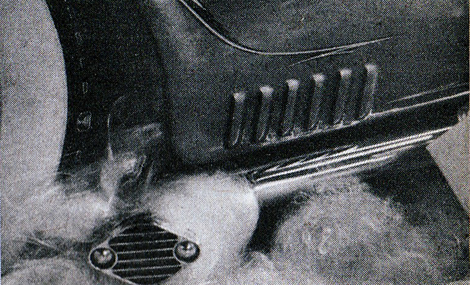 Here's an arrangement for the re-styler who wants to beat his show rivals to the punch, louvers located in the front of the wheel opening.
Here's an arrangement for the re-styler who wants to beat his show rivals to the punch, louvers located in the front of the wheel opening.
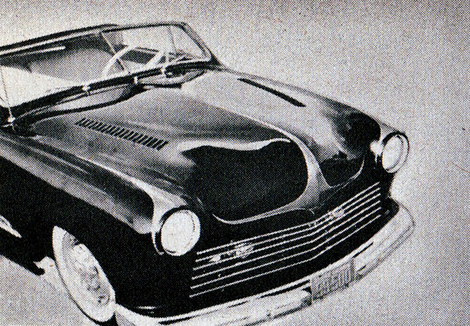 Another example of a hood treatment, with single rows of louvers positioned on the outboard sides. Clever scalloping helps achive streamlining effect.
Another example of a hood treatment, with single rows of louvers positioned on the outboard sides. Clever scalloping helps achive streamlining effect.
 No job for a novice in this unusual treatment. Custom-made rear pan was louvered first, then shaped to the '55 Thunderbird.
No job for a novice in this unusual treatment. Custom-made rear pan was louvered first, then shaped to the '55 Thunderbird.
 For some reason, wide louvers are not too common, but careful planning can result in a unique effect, as seen on this '53 Buick.
For some reason, wide louvers are not too common, but careful planning can result in a unique effect, as seen on this '53 Buick.
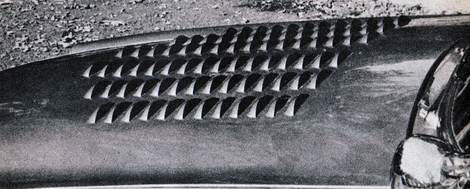 Louvers are as varied in shape as they are in size and pattern. Rounded louvers, like those shown here, are more noticeable than other shapes.
Louvers are as varied in shape as they are in size and pattern. Rounded louvers, like those shown here, are more noticeable than other shapes.
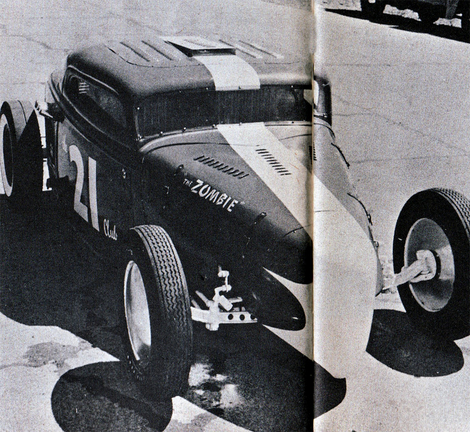 Louvered roof is usual enough, but here's a stint that is really different rows of louvers complemented by a louvered scoop. What's more, the openings are functional. Louvers, in the hood face front, while those on the rear provide all-around cooling.
Louvered roof is usual enough, but here's a stint that is really different rows of louvers complemented by a louvered scoop. What's more, the openings are functional. Louvers, in the hood face front, while those on the rear provide all-around cooling.
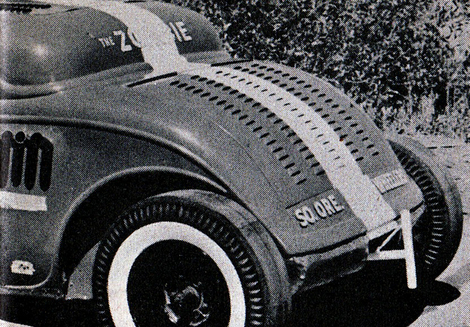 Deck lid is a favorite place for locating louvers on competition machines. And it's especially practical when engine is mounted in the rear, as in this case of this coupe. Owners didn't stop at the deck, however.
Deck lid is a favorite place for locating louvers on competition machines. And it's especially practical when engine is mounted in the rear, as in this case of this coupe. Owners didn't stop at the deck, however.
 *There's no stopping the re-styler who likes his louvers way out (and out of this world). For an array of the punchiest louvers this side of the moon, check rocker panel vents in this wild pick-up.
*
*There's no stopping the re-styler who likes his louvers way out (and out of this world). For an array of the punchiest louvers this side of the moon, check rocker panel vents in this wild pick-up.
*
How They're Made
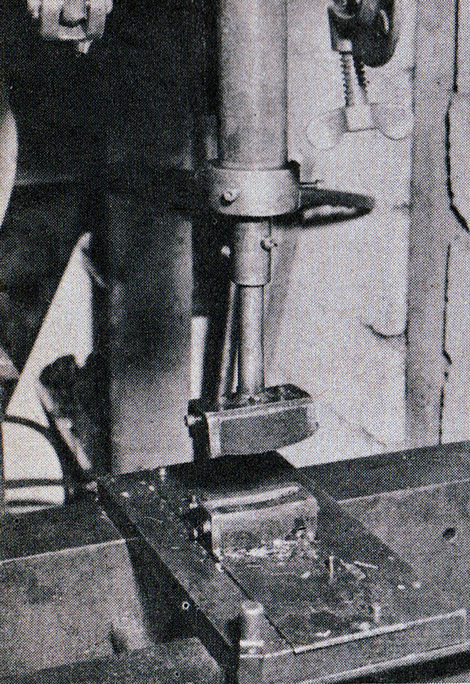
* Louver press operates hydraulically. Dies are interchangeable for wider or narrower cuts.
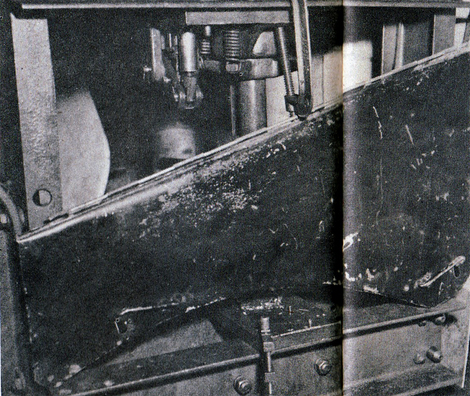
* Preparing a side panel for the punch treatment. Outside surface should be placed face down.
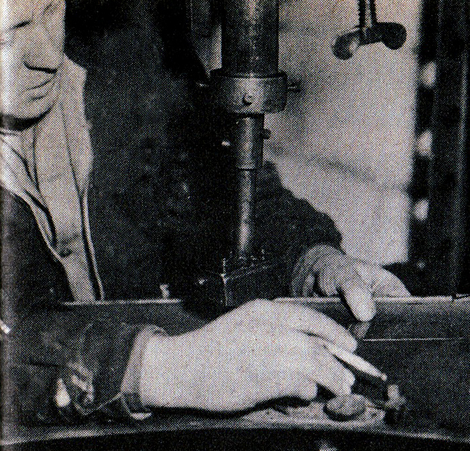
* With interior surface face up, cutter marks off the guide lines.
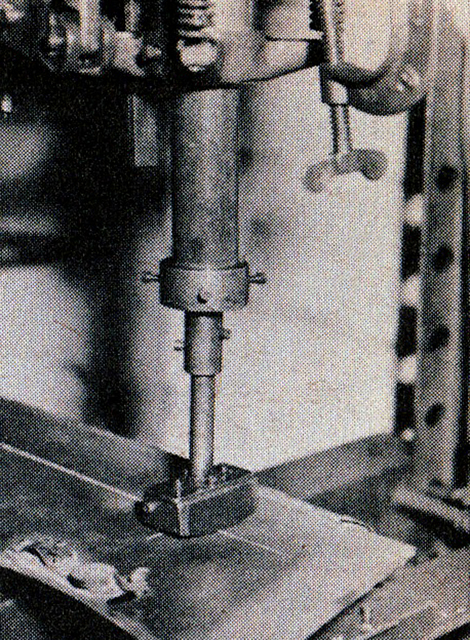
* Die is lowered to the precise spot for the initial punch.
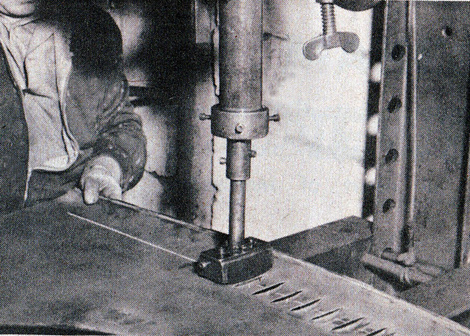
* Remaining louvers are then carefully spaced along line. Wide variety of patterns possible.
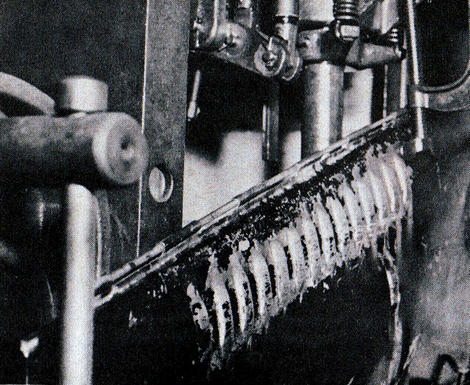
* After louvers are cut, all that remains is to file the edges and repaint the area.
Some louvers I have seen lately at some of the shows I attend:
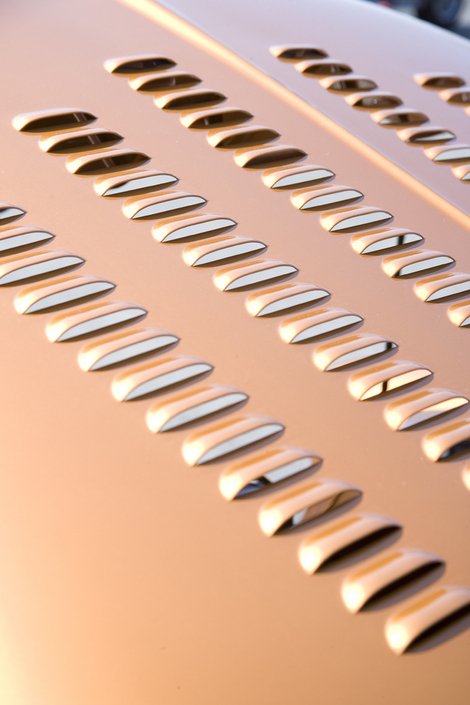 Beautiful pattern across this hood.
Beautiful pattern across this hood.
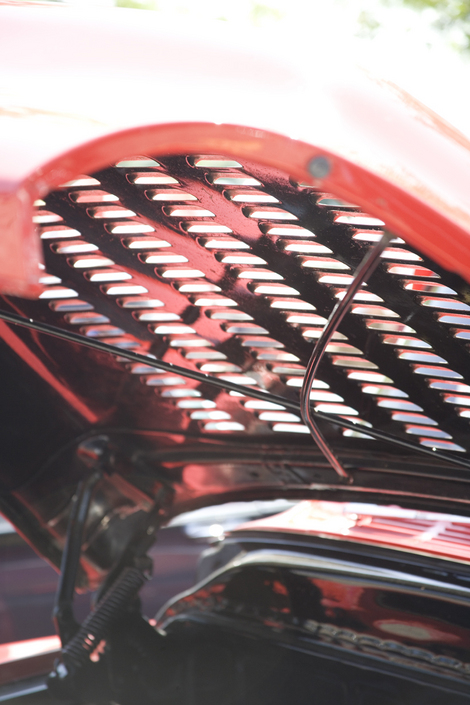 Louvers are just as beautiful from under the hood as they are from above as seen here.
Louvers are just as beautiful from under the hood as they are from above as seen here.
 Another finely done hood.
Another finely done hood.
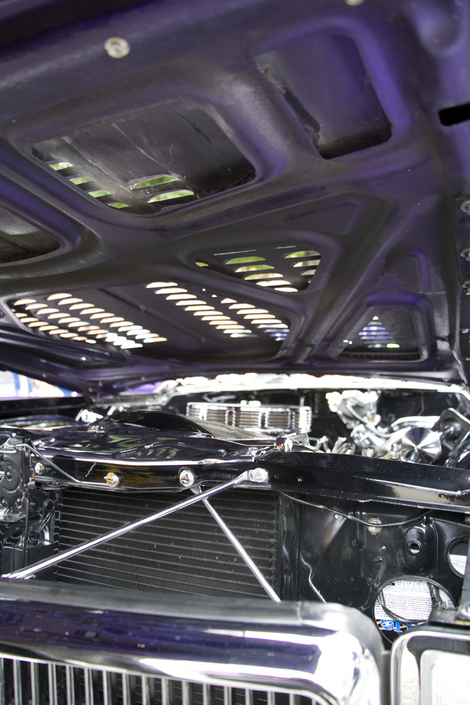 Another view from under the hood of this truck.
Another view from under the hood of this truck.
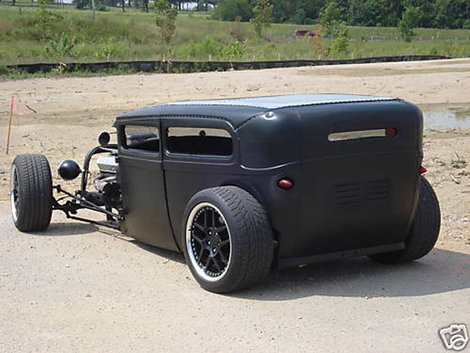 The louvered rear of this 1929 Ford.
The louvered rear of this 1929 Ford.
As you can see louvers have been an integral part of the Hot Rod and Custom scene since its very beginnings adding a cool aesthetic to the machine they grace and with the imagination of the designer. Next I will be recreating an article from this same magazine issue -18 LOW-COST Grille Treatments.
Don't miss it!
Posted 09/14/08 @ 10:01 PM | Tags: Louvers, fabricating louvers, Hot rods, lead sled louvers, hot rod louvers, air vents, air slots, wheel cover louvers, Rodding and Re-Styling magazine August 1960, hot rod fabrication